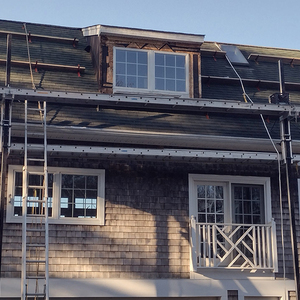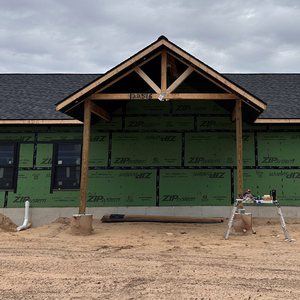Don’t aim a nail gun at your hand
I gasped when I opened my mailbox and saw the December 2000/January 2001 cover of Fine Homebuilding (FHB #136). Recently, I found myself in an almost identical position as the framer in the photograph, except that his day probably ended with tacking down floor sheathing, whereas mine ended in the emergency room.
I was using a framing nailer to secure a top plate to a series of studs. My right hand held the nailer while my left supported and aligned each stud. My mistake was shooting the top-most nail first while my left hand was still downrange of the gun. The nail skidded off the edge of the plate and planted itself securely in the base of my thumb. I knew what I had done without even looking. The dull thud and sharp pain said it all.
The physician informed me that the embedded nail lay about 1⁄4 in. away from the digital nerve, which controls the basic motions of the thumb, and probably just skimmed the surface of the bone. I got off fairly easily for being so close to a permanent disability.
If you need to support a piece of lumber, do it with a hammer or other inanimate object. If you absolutely must hold a piece of lumber with your hand, shoot the bottom nail first, then clear your support hand out of the area.
—Christopher Dundorf, Barrington, NH
P. S. Thanks to Chris and Bobsie at the Barrington Medical Center for removing the foreign object from my hand as quickly and professionally as they did. I’ll never look at bolt cutters and Vise-Grip pliers the same way again.
Readers liked the Texas builder’s take on affordable housing
Kudos to Dan Phillips on his fine article, “Making the American Dream Affordable” (FHB #136, pp. 94-99). It is so refreshing to hear his story. He points out how our conventional materials and methods dominate everything at the expense of our resources. It is imperative that those of us building houses learn not to be so wasteful given the state of our environmental health. Our goal should be to create housing that is environmentally sustainable. There are other ways to build quality houses. However, convincing the market, not to mention our governing authorities, that alternative building methods are viable will be our biggest challenge. In the meantime, it is the pioneering, new-age craftsmen like Mr. Phillips who must rise up and push against the status quo to help change our ways for the sake of humanity. Thank you for the article.
—Van Waters, St. Simons Island, GA
Wow. I have often glanced through Fine Homebuilding, which I buy for my builder husband. But when he pointed out the article by Dan Phillips, “Making the American Dream Affordable” (FHB #136, pp. 94-99), I was astounded and elated. And I thought you were a big-money, glitzy mag. I hope this article inspires others (and maybe us) to do the same.
—Patricia Coe, Port Angeles, WA
Reader says OSHA is not a small town in Wisconsin
I love to open a fresh issue of Fine Homebuilding and find such great articles and tips every month. I have found no other magazine that is actually worth the money. But sometimes I wonder if anybody’s checking the photos. On p. 94 of FHB #136, there’s a photo of author Dan Phillips sitting on a pile of soon-to-be-reclaimed lumber at a project of his. I respect Dan for using job-site waste, but look behind him! There’s a guy about 20 ft. in the air, perched on a rickety scaffold made of 2x10s. You can even see deflection. If you’re daring, okay. But OSHA is not a small town in Wisconsin. Save money somewhere else. Go rent some scaffolding or get a ladder. Don’t nail 18-in. 2×4 braces to a vertical 2×10 and call it safe.
—Rob O’Keefe, via e-mail
Dan Phillips replies: At the time the photograph was taken, the scaffolding was in the process of being taken down. It did actually have a handrail, and those are OSHA-approved scaffold boards. We were trying to get the scaffolds down so that more finished photos of the front of the house could be taken. The fact that the skimpy leftovers were still there is, of course, a bit embarrassing. The abiding rule on my job site, however, is that if you go higher than an 8-ft. stepladder, you tie yourself off with harnesses, ropes and standard clips—and there are no exceptions.
Not all surface-mounted lighting is bad
I was surprised at Sarah Susanka’s assertion in her column “What to expect from light fixtures” (FHB #136, “Drawing Board,” pp. 40, 42, 44) that surface-mounted ceiling fixtures are tough on ambience, particularly in older homes. Although I agree with her that there is a plethora of surface-mounted fixtures that are ugly, cheap and in conflict with the architecture where they reside, there are also surface-mounted choices that are beautiful and affordable, and enhance architecture through sympathetic lines and materials.
As the nation’s largest manufacturer of authentic brass reproduction lighting, we carefully select lighting for all periods and sizes of old homes and buildings to reproduce. Linear and sturdy Craftsman fixtures mirror simple pleasing woodwork; curvaceous and detailed Victorian fixtures parallel the celebration of decoration; and romantic colonial fixtures echo the motifs and lines of 18th-century predecessors.
As Susanka so rightly points out, lighting is often ignored until the last minute and then not done well. I encourage your readers to use historic references for selecting details sympathetic with their projects.
—Mary Roberts, president and CEO, Rejuvenation Lamp and Fixture Co., Portland, OR
More comments on screw guns
I enjoyed the article by Derek McDonald, “Survey of Autofeed Screw Guns” (FHB #137, pp. 92-97). I have not had the good fortune to test such a wide variety of auto-feed screw guns as the author has. The only two models that I have tried are the Quick Drive QD2000XL and an older version of the Quick Drive coil screw gun. Here are a few additional thoughts that I had on the subject.
First, a contractor should be aware that different screw guns operate at different rpms. The faster screw guns are mainly designed for drywall applications. They don’t work quite as well for flooring or especially decks. They tend to bog down and not countersink fasteners fully. The lower-speed, higher-torque screw guns work better for flooring and decking.
Also, I have found that with the Quick Drive system, Phillips-head screws work much better for drywall. They tend to cam out easier than the square drive, causing fewer problems with punching through. And drywall dust can adversely affect the operation of the autofeeder, so it pays to keep an air hose handy for blowing out dust.
My experience with Quick Drive has gone well. The customer-service reps I had to deal with when I dropped a 2×4 on the autofeeder were very accommodating. I told them what happened and what part I needed, and they sent it to me at no charge. I have limited experience with the coil-feed type, but I think that the convenience of loading the short, rigid, rope-style strips outweighs the need to reload more often, as in a coil type.
—Talus J. Lowman, via e-mail
Watch out for shear walls when retrofitting larger doors and windows
You may want to add a caveat to the article “Framing an Opening in a Bearing Wall” (FHB #137, pp. 68-71). In areas like California, we have earthquakes. Most of the rest of the country has wind. If the wall you cut has shear value, you weaken the structure with a larger opening—particularly any wall that is nailed off with plywood or oriented strand board and lots of nails. Such a wall is usually doing duty as a shear wall. I would have someone familiar with structural engineering evaluate any such work before cutting an existing wall.
—Geoff Sheldon, via e-mail
Most readers still argue for shimming door jambs
After reading “To shim or not to shim” in the “Letters” section of your last issue (FHB #137, pp. 10, 12), I felt that as a conscientious carpenter turned stickler-for-detail general contractor, I must respond.
Neither Mr. Katz’s nor Jim “The Shim” Irvine’s methods are adequate. Doors should have five shim points up each side of the door, always a shim point at the top in the head jamb and always the jambs sitting square in the openings, especially when atop floor tile, linoleum or hardwood. With today’s nail guns shooting a thin wire nail, a door installation needs all the help it can get to stay secure for years to come.
I see so many shortcuts nowadays it’s sickening. But this isn’t just the fault of the so-called craftsmen; it’s also the fault of the customers who look only at the bottom line of a bid and think they are comparing apples to apples. In fact, they are the ones who will pay for callbacks and premature maintenance along with their mortgage. I can’t wholeheartedly fault some techniques that I find inadequate, but I can fault our system in general. It sticks us with unbearable workman’s compensation, taxes and insurance costs, which means our trades must cut somewhere, and unfortunately, it ends up being cutbacks in workmanship and material quality.
—Frank Sromoski Jr., Mountaintop, PA
Mr. Katz is still way off base concerning his shimming article. Every door, even a hollow-core, should be installed with shims. The first time someone rams a piece of furniture into an unshimmed door jamb, its integrity is history.
—Bill Bartlett, via e-mail
Gary M. Katz suggests installing prehung hollow-core door units without shims. I assume this fellow will never, ever sell a home to someone who may change door styles … possibly to a solid six-panel unit or similar type door. I’m sorry, but if he worked for my company, I’d fire him on the spot for making such a suggestion. As a craftsman and homebuilder, I hope I don’t run into another article suggesting anything close to this type of practice.
We have a motto at our company: “If it comes too easy, it won’t last.”
—Neil Jackson, via e-mail
Just says no to torch-down membranes
I read the article “Building a Deck Over a Living Space” in the last issue (FHB #137, pp. 104-107). I have just one thing to say. Torch-down membrane: no way! After a crew of roofers set my house on fire putting a torch-down membrane on the flat roof of my garage, I will take my chances with EPDM. Only quick and efficient work by my local fire department kept my house from being totaled.
—John Foster, via e-mail
Locating a chimney in a valley isn’t the best idea
Congratulations on 20 years of consistently good writing and service to the field of home building.
The February/March 2001 issue (FHB #137, pp. 110-115) presented a charming house by architect Peter Manning on Puget Sound that contains what I consider a design flaw. The photograph on p. 110 shows the brick chimney penetrating the roof smack in the middle of a valley. The quality of the flashing appears expert, so I am sure that the more difficult uphill side is expertly done as well. It has to be. To divert the water from the valley to each side of the chimney requires a good hand with geometry and materials and a strategy for keeping water from the several points where three planes intersect. Then there’s maintenance.
This detail has a strong pedigree from Arts and Crafts and the Tudor revival, thus its recurrent appeal to designers. But it poses one of the toughest challenges to roofers (the other being the dead valley resulting from intersecting gables). Perhaps you could address expert-level flashing in a future article.
—William B. Rose, research architect, Building Research Council, University of Illinois at Urbana-Champaign
Tell readers it’s cool to wear safety glasses
I’ve read the “About your safety” disclaimer that runs at the end of the “Letters” column several times, and it hits the nail on the head, no pun intended. Everyone needs to wake up and not depend on someone else to keep you safe.
I’ve also read with bone-chilling interest your safety articles, such as the one about a router accident (FHB #102, pp. 92-95). We all need to hear this stuff. I happen to work for one of the most safety-oriented companies in the world. Our policy is that all accidents are preventable. Each and every accident is investigated, and improvements are implemented.
Anyway, I know you can’t catch everything before it goes into print, but try to look a little closer at photographs with safety in mind. In the photo on p. 130 of your last issue (FHB #137, “Tools & Materials”), the guy using the siding stapler isn’t wearing eye protection. I am not proposing that you turn into a safety magazine, but I think a simple thing like putting safety glasses on that guy might show some kid that it’s not uncool to wear them.
—Chester E. Bluck, Bear, DE
Fake can be fine
I was dismayed when I saw someone canceling his subscription because cultured stone was shown in an article (FHB #133, “Letters,” p. 6). Please don’t let the stonemason deter you from featuring imitation materials. I’ve been following my husband around for the past 20 years, leading a nomadic lifestyle due to his profession in the military. Every month, I try to put money aside for the house we hope to build someday. As much as we’d love to be able to enjoy the real thing, I doubt our budget will allow it. We’ve been excited to see the development of great “fakes” in the home-building arena. We have a right to the “look” of the real thing. Wouldn’t you agree?
—Mary Lesniak, Aberdeen Proving Ground, MD
Fine Homebuilding Recommended Products
Fine Homebuilding receives a commission for items purchased through links on this site, including Amazon Associates and other affiliate advertising programs.

Affordable IR Camera

8067 All-Weather Flashing Tape

Handy Heat Gun






















